Ask the Builder: Oxygen bleach is the best way to clean outdoor wood

Q. Every year, I have wood or composite decking to clean outside. This year, I need to clean and reseal a ramp that leads up into my outdoor shed. I also see conflicting information on the internet about the best way to clean wood. Many say to use a pressure washer. What do you feel is the best way and why? What do you feel is the best sealer, and how long can I expect one to last? – Wendy B., Bangor, Maine
A. I have a similar spring routine at my home. I have a boat dock with cedar panels and a large set of treated lumber steps leading from the shore to the dock. I also have a treated-plywood ramp that allows me to get my motorcycle and snowblowers in and out of my shed with ease. All of this wood requires periodic cleaning and sealing so the wood isn’t ruined by Mother Nature.
The internet is a wonderful thing, but one of the downsides is that it gives everyone a voice. While that might seem like a great thing, it often makes it difficult for you to separate the wheat from the chaff. Each day, I battle fancy websites created by people who’ve never worked a day in a paying customer’s home, yet the website owner thinks he’s an authority on all things having to do with home improvement.
Here’s a fact about pressure washers and wood. Pressure washers can be highly destructive even in the hands of a paid professional. The intense stream of water forced from the nozzle of the wand is measured in thousands of pounds of pressure per square inch.
This forceful blast has no trouble at all eroding the soft, lighter-colored wood fibers in between the darker bands of the wood grain. The light wood is called springwood, as it’s what grows in the spring. The darker bands of wood are summerwood. These are far denser and grow in the second half of the season before fall arrives.
I prefer to clean all my outside wood with a solution of oxygen bleach and water. This chemical is safe for all vegetation around the wood, it doesn’t take out the natural color of the wood, and it removes old, sun-damaged wood sealers with ease. I apply it to dry, dirty wood and composite decking, let it sit for 15 minutes, scrub with a brush and then rinse with a garden hose.
Do not use chlorine bleach. The chemical name for chlorine bleach is sodium hypochlorite. It’s very toxic to vegetation, it turns wood white, and it’s corrosive to any metal fasteners or structural connectors.
It’s best to let the wood dry well after cleaning. There’s a good chance you’ll see peach fuzz on the wood. These are tiny wood fibers that are just hanging on for dear life. The sun damaged them, and the cleaning process didn’t remove them.
I’ve had great luck using 60-grit sandpaper to remove the fuzz. To save your back, you can use a sanding tool that drywall finishers use. It’s got a pad at the end of a pole with a swivel head. You can attach sanding screens to the tool or use traditional sandpaper.
Aluminum oxide paper is the paper I love to use because it’s self-sharpening. This paper is normally a medium brown color. Avoid the reddish-orange sandpaper that’s made with garnet. The abrasive particles round off as you use it, and it burnishes the wood.
I’ve had the best luck with penetrating wood sealers. These soak into the wood grain once the wood is clean and dry. Many popular exterior wood sealers are similar to paint. They form a protective film on top of the wood. The trouble with film formers is that when they fail, they peel like paint. If you don’t get all the film off, you can end up with a blotchy finish when you apply the new sealer, as the sheen might be different where it’s bare wood vs. where the new sealer covers the film you weren’t able to remove.
Be sure to read the label on the can of sealer. Follow the directions to the letter making sure you pay attention to the temperature ranges. It’s best to apply the new sealer on overcast days or in the shade. Working in direct sunlight can cause rapid drying, which will lead to overlap marks where you failed to apply the sealer fast enough.
Some sealers want you to apply two coats but within a specific time frame. Read the label to make sure you understand what to do as the second coat adhesion depends on you following the directions.
Subscribe to Tim Carter’s free newsletter and listen to his new podcasts at askthebuilder.com.